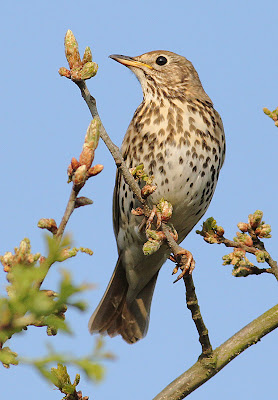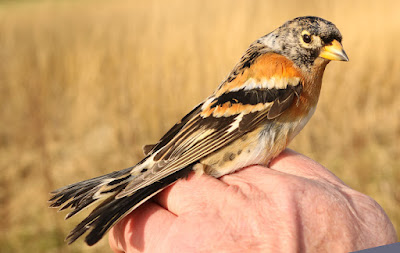“Comes in like a Lion, goes out like a Lamb.” - attributed
to Thomas Fuller’s 1732 compendium, “Wise Sentences and Witty Sayings”.
Thomas - I am not amused by your witty saying. Another week of weather watching has seen a
couple of pencilled in days scrubbed from the ringing diary as March roars like
the proverbial Lion. Thursday was looking good, Thursday moved to Saturday and
now that too looks unlikely. And there’s little sign of lambs gambolling in spring sunshine.
So friends, it’s back to the archives today with a few
pictures of Bramblings and others from December 2012 when there was something
of a “Brambling Winter” and our ringing group processed more than 70 Bramblings
between September 2012 and April 2013.
~~~~~~~~~~~~~~~~~~~~~~~~~~~~~~
Did last week’s blizzards in Eastern Europe, dubbed “The Beast From The East” cause Bramblings to head west? This morning I caught 4 new ones in the plantation at Out Rawcliffe, making nine this week. It’s not a huge number in the grand scale of the millions in which Bramblings can flock in Europe, but it could mean many more are heading this way soon.
Bramblings can be overlooked in apparently single species flocks of very flighty Chaffinches, the Bramblings giving away their involvement by the slim, white rump. Very often a Brambling will give out a nasal contact call but sometimes not, when the unremarkable chattering flight call can be overlooked in the calls of accompanying Chaffinches. Click on the "xeno canto" button to hear Brambling calls.
Brambling
I think the attraction at Rawcliffe is the nyger feeders and the small amount of mixed feed on the ground, a mixture which contains sunflower seed. During the last large influx of Bramblings in 2010/2011 many took to using garden feeders. As a species they were very dominant in the feeding hierarchy by chasing off most interlopers.
Brambling
Brambling
It was a short session, a late start only when the sun warmed the air, followed by a hasty pack up when a strengthening easterly wind blew through leafless trees and billowed the nets.
So, 4 Brambling, 4 Chaffinch and a Goldfinch with no recaptures of the Bramblings from Tuesday.
Brambling
Brambling
The dullish female pictured above had very visible fault bars.
Brambling - fault bars
There were a good number of birds to take note of this morning, with 2 Buzzard, 2 Kestrel and a Little Owl before I even reached the farm. The owl had puffed up to keep warm air in those feathers.
Little Owl
Buzzard
In between the bit of ringing I clocked up 1 Sparrowhawk, 2 Snipe, 35 Fieldfare, 22 Redwing, 32 Skylark, 15 Reed Bunting, 250+ Lapwing, 1500+ Woodpigeon, 1 Mistle Thrush and 2 Raven.
Fieldfare
There’s more news from North, South, East and West pretty soon from Another Bird Blog, so log in soon to find out just where.
~~~~~~~~~~~~~~~~~~~~~~
Fingers crossed that I get out soon. Maybe a Brambling or two from the supplementary food dropped at Cockerham.
Thursday 10 March 2022.




























































.jpg)












